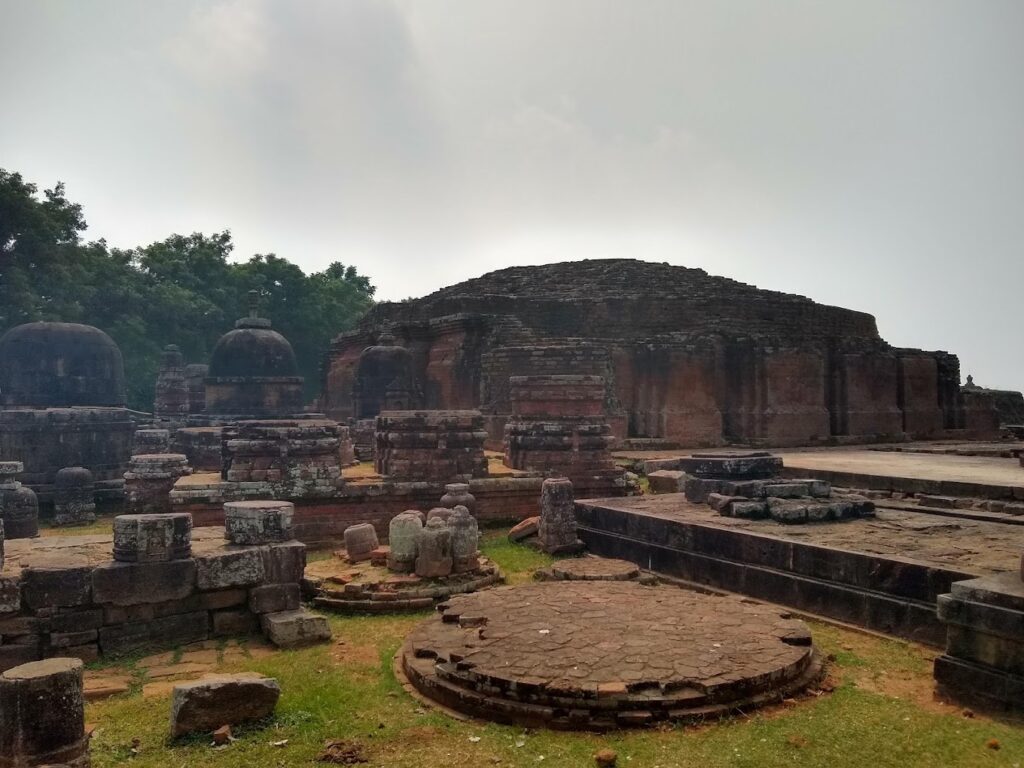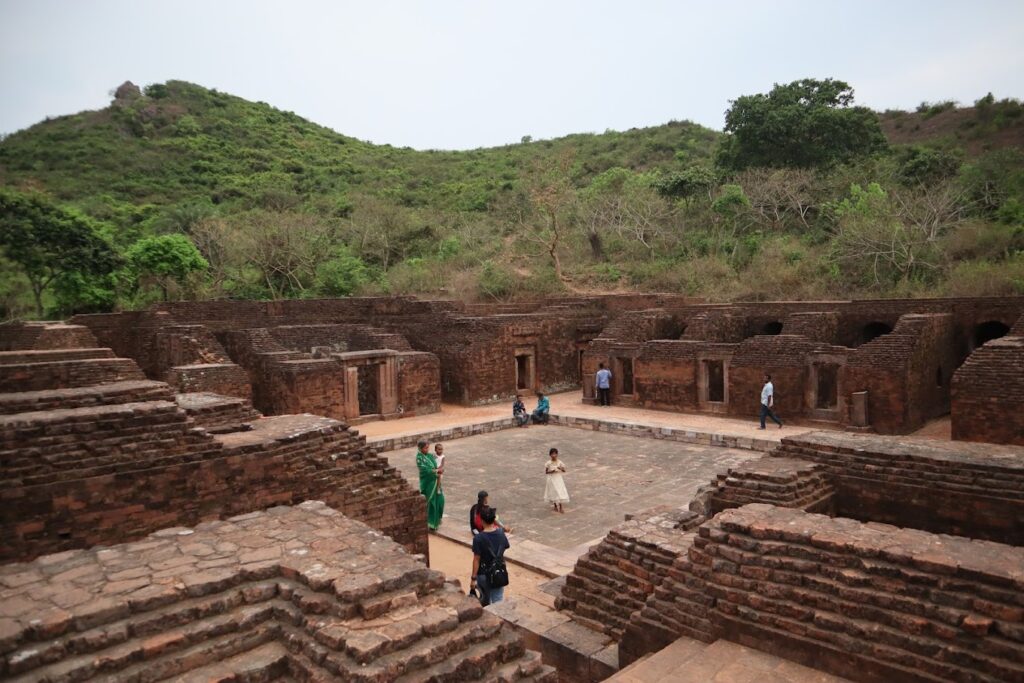Ratnagiri Excavation Site- History, Architecture, Entry Timings, Ticket Price, and Much More!
One of the well-known Buddhist archaeological sites in Odisha is found in the form of Ratnagiri, which is located around 100 Kilometers from the city of Bhubaneswar. This Buddhist archaeological site is situated on a hill between the Birupa and Brahmani rivers.
This location was formerly a significant Buddhist center in the state, according to the excavations that were done there. Ratnagiri completes the Diamond Triangle of Buddhist centers in Odisha, together with the other two Buddhist sites Lalitagiri and Udayagiri. In comparison to the other two, Ratnagiri, which means “Hills of Jewels” in the native tongue, has been the best excavated.
According to Cleveland University professor Thomas Donaldson, who is well-known for writing numerous works on the history and art of Odisha and India, Ratnagiri was on par with Nalanda in terms of Buddhist knowledge. He also notes that Ratnagiri has been identified as the birthplace of the Tantrayana and Mahayana Buddhist sects in some of the most revered Tibetan writings.
The main stupa and three monasteries’ ruins were successfully uncovered by Archaeological Survey of India (ASI) archaeologists in Ratnagiri during excavations. In addition to this, a large number of votive stupas and memorial stupas were discovered; the former was constructed in honor of monks with their relics, while the latter was constructed in response to the fulfillment of wishes. These stupas provide evidence that Ratnagiri was a significant pilgrimage site even during that time period.
The ASI is currently in charge of overseeing the location. It has built a museum here, where a number of Ratnagiri-related artifacts and sculptures that were unearthed have been placed and displayed. The museum contains details on the various stages of the excavations that were done at this location.

History of Ratnagiri Excavations in Bhubaneswar
It has been established via archaeological research at Ratnagiri that Buddhism was a thriving religion in this area from the 5th century AD to the 12th century AD. But after that, it started to fall apart, and by the 16th century, it was a ruin. According to some evidence acquired, Hiuen Tsang, a well-known Chinese Buddhist monk, and traveler, is said to have made a stop here.
Prior to the ASI starting active excavations here in the 1960s, the site of Ratnagiri was lost to history. As a result, numerous stupas and Buddha sculptures were discovered in addition to the monasteries. In addition to them, a number of other exceptionally good sculptures were also unearthed. Some of these are currently on display in the adjacent museum, while others have been moved to different ones all around India.

Architectural Wonders Of Ratnagiri Excavations Site
The ruins only of the Buddhist site at Ratnagiri are evidence of the period’s exceptional architectural talent. The architectural artistry is of the finest caliber, whether it be in the monasteries, the main stupa, Buddha statues, votive stupas, memorial stupas, or the intricately carved apartments.
Monastery 1
Of the three monasteries at Ratnagiri, it is the largest and most beautifully carved. The only monastery in the nation with a curved roof is this one. This monastery’s elaborately carved gateway, which is composed of chlorite, is its most notable feature. One of the most photographed Buddhist-related buildings in the world, this entryway opens to a spacious courtyard. The enormous head of Lord Buddha is the most notable of the many treasures and relics that have been stored in the courtyard.
In this courtyard, there are also numerous surviving door frames, deteriorated wall panels, and Buddha heads of various sizes. At the far end of the courtyard is Monastery 1’s main sanctuary. A large statue of Lord Buddha and two exquisite sculptures of Vajrapani and Padmapani can be found in the sanctum. Monastery 1 was thought to have had two levels, but all that is left of it today is the bottom floor, which has 24 cells.
Monastery 2
This monastery is much smaller than Monastery 1 and only has a ground floor with 18 cells. It is situated to the west of Monastery 1. A picture of Shakyamuni Buddha can be found in the monastery’s main shrine. Various little carvings, votive stupas, and a few small temples with sculptures can be seen outside the monastery.
Monastery 3
This monastery is a modest structure with only three cells and is situated north of Monastery 1. As a matter of fact, this is now the Ratnagiri Archaeological Museum.
Main Stupa
A short distance from Monastery 2 is Ratnagiri’s main stupa. This stupa, which stands 17 feet tall and is visible from the highest point in the area, is thought to have been built in the ninth century based on archaeological evidence. It is currently partially destroyed. Most of the 700 votive and memorial stupas discovered at Ratnagiri are dispersed around this big brick stupa and numerous smaller stupas.
Beyond the main stupa and down the hill is the 15th-century Mahakala Temple. This shrine was once built on top of a Buddhist stupa. The ASI moved it to its current site, Between 1997 and 2004.

Things To Explore in Ratnagiri Excavations
The Ratnagiri Buddhist Excavation site has a wealth of archaeological relics to discover. Visitors who have an interest in this kind of archaeology will be enthralled by the exhibits at this location. To learn more about this Buddhist site and the excavations that have taken place here since the 1960s, they should also go to the museum.

Entry Timings Inside Ratnagiri Excavations
From 9 am to 5 pm, visitors can visit the excavation site. With the exception of Fridays, the museum is open every day of the week.
Ticket Price System in Ratnagiri Excavation Site In Bhubaneswar
How to Travel To Ratnagiri Excavations
Ratnagiri Buddhist Excavation Bhubaneswar Address: Ratnagiri, Bhubaneswar, Odisha, 755003, India
The Biju Patnaik International Airport is roughly 96 km away from the Ratnagiri Buddhist Excavation site, and the Bhubaneswar Railway Station is located about 92 km away. About 96 Kilometers away is the Baramunda ISBT, which receives buses from towns in Odisha and adjacent states. If you take a private car then it will approximately take two and a half hours by road.
Things to Remember While Visiting Ratnagiri
- There is a parking facility on the property.
- It is forbidden to venture past the barbed wire and attempt to touch the buildings.
- Since there are no nearby food establishments, it is best to bring your own packed meals.
- Avoid going there in the late afternoon or when it’s too hot outside.
When one travels to the Ratnagiri Buddhist Excavations, they have the chance to experience the spiritual atmosphere of a long-gone era, see the splendor of old Buddhist art and architecture, and learn more about the region’s cultural and historical roots. The deep wisdom of Buddhism continues to inspire and enthrall visitors on this journey of discovery where history comes alive. These digging sites serve as a timely reminder of the value of protecting and cherishing our cultural heritage since it is only through studying these antiquated artifacts that we can truly connect with the past and obtain understanding that will help us create the present and the future.